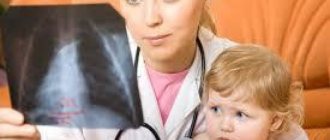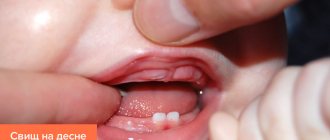Indications for removal of baby teeth
In the absence of pathologies and good dental health, the renewal of the child’s bite begins at approximately the age of 5-7 years. The permanent molars are already ready to replace the baby teeth, so the latter become mobile and often fall out on their own.
The ideal scenario makes everyone happy, but sometimes the removal (extraction) of baby teeth is an objective necessity. Indications are determined by the dentist:
- Loose baby teeth. The strong mobility of the changing tooth bothers the child. Unpleasant sensations occur when talking or eating. There is a danger of gum inflammation.
- Supernumerary tooth. An extra unit interferes with the formation of a correct bite, so after consultation with an orthodontist it is often recommended to be removed.
- Beginning of permanent molar tooth eruption. In this case, the baby tooth becomes a nuisance, which it is advisable to remove as soon as possible.
- Severe tooth decay due to deep caries, pulpitis or periodontitis. The dentist will make every effort to save the baby tooth, but in case of serious damage to the crown, there is only one solution - removal.
- Crack and mechanical damage. A crown split, root fracture and other consequences of severe trauma are a reason to remove the destroyed unit.
- Bite correction. To ensure the correct positioning of teeth in the jaw, it is often necessary to forcefully remove individual units. But this is done after consulting an orthodontist.
- Inflammatory processes in the area of the tooth root. Granuloma, fistula or cyst is a threat to the health of the root system of permanent elements. Usually, the doctors at AzaBuka Pediatric Dentistry manage to cure the inflammation. If not, removal is inevitable.
The reasons for the removal of temporary teeth can be very different, but modern pain relief techniques make the extraction procedure painless and comfortable for the child. It is best to schedule an adaptation visit as your first appointment. If the baby is already familiar with doctors, then you can immediately make an appointment with a dental surgeon.
Adaptation in dentistry is a series of introductory sessions for children, during which children are introduced to the work of dentists, equipment, and tools. Communication takes place in a fun, playful way with the display of informational cartoons, fairy tales, and interesting dental models. After adaptation techniques, children cease to be afraid of doctors and willingly agree to all types of treatment.
How to prepare a child
Removing baby teeth is a whole ordeal, not only for children, but also for parents. Most children are afraid of all kinds of manipulations by the dentist, so parents should psychologically prepare the child for the procedure, explain that everything will go easily and quickly. Under no circumstances should you tell your child: “It doesn’t hurt” or “The doctor will give you an injection and you won’t feel anything.” Parents should teach their children from an early age that a visit to the dentist is necessary, develop a positive attitude towards regular preventive care, then a visit to remove a baby tooth will not frighten the child at all.
The main thing is to be nearby during the procedure, because parental support is very important.
Is it painful to remove a child's baby tooth? Anesthesia decides everything!
The question of tooth pain relief during extraction is the most frequently asked question by parents. The wishes of adults vary: some want extraction without medications, others insist on full anesthesia. AzaBuka provides several anesthesia methods for children, and when selecting, the doctor always focuses on the individual characteristics of young patients.
In rare cases, they do without pain relief. This is real if the baby tooth is very mobile, and its permanent replacement is already emerging through the gums. In this case, the doctor removes the tooth during an examination of the oral cavity, and the child does not even notice the manipulation. There is simply no point in worrying about whether it is painful to remove a baby tooth in children, but such techniques are rare.
Plaksina Margarita
“One young gentleman had his upper tooth so loose that it was turning in all directions. But it didn't fall out. The boy did not let his parents pull the tooth, but he allowed himself to be examined at the reception and quite willingly opened his mouth. Imagine his surprise when I put the pulled out tooth on his palm literally a minute later. He left happy - with a reward for courage and a milk tooth in his hand.”
Most often, dentists resort to local or thorough anesthesia - they use one of the types of modern anesthesia:
- Superficial. The doctor treats the gums with a special gel that gives a slight freeze. This is done for easy removal of highly mobile teeth or at the site of a future anesthetic injection.
- Local (infiltration). To administer the anesthetic, the doctor uses a syringe with a very thin needle, so the discomfort is minimal. The selection of the drug is carried out in the presence of parents to eliminate the minimal likelihood of an allergic reaction.
- Sedation, shallow sleep. The technique is becoming increasingly popular - both children and adults enjoy it equally. Using an inhalation mask, the child is offered to breathe a special gas - a mixture of nitrous oxide and oxygen. The relaxing effect puts the patient into a state of semi-sleep. The baby understands everything, can follow the doctor’s requests, but does not panic, is not nervous or worried.
Tooth extraction in a dental clinic
A dental clinic is the best option where you can have a tooth pulled out without pain. The procedure will not take much time. First, the dentist will examine your mouth and take an x-ray if necessary. During the examination, the doctor will determine the root system of the tooth, its location and the structural features of the tooth to be removed. Then the orthodontist will calculate the appropriate dose of anesthesia, due to which the patient will not feel any discomfort during the procedure.
Usually the tooth is pulled out under local anesthesia, but if the patient is very afraid (especially for children) or has a serious incident, then general anesthesia is used, during which the person falls asleep and wakes up after the operation is completed.
After removal, the site of the extracted tooth is cleaned and filled with a special substance that prevents inflammation, infection and atrophy of the jaw bone. You can find out how much it costs to have a tooth pulled at the City Smile dental clinic in the corresponding section of our website. You will be satisfied with the price and quality of the procedure performed.
The benefits of having teeth removed in the dentist's office include:
- use of high-quality painkillers;
- use of disposable materials and clean tools;
- 100% compliance with sanitary and hygienic standards;
- a professional approach that involves diagnosis and taking into account the structural features of the jaw;
- providing assistance in case of complications;
- no pain.
Tooth extraction is a surgical intervention that violates the integrity of the gum and penetrates into its canals and roots. So, various complications may await the dentist during his work. But eliminating them is much easier and safer in a clinic than, for example, at home.
General anesthesia.
Removal or treatment of teeth in a dream is prescribed for certain indications. The appointment is carried out under the supervision of an anesthesiologist with the mandatory use of monitoring equipment.
Dolotova Marina
“Is it painful to remove a baby tooth for a child under sedation - if it doesn’t wobble? Absolutely not. Usually during the appointment, the children watch cartoons while I carefully remove the tooth. And before that, we play superheroes with them and be sure to try on a real mask - a prototype of the Iron Man helmet!”
Preparation
How to extract a child’s tooth at home if it is loose but does not want to fall out on its own? First you need to make preparations.
- First, you need to understand whether you can carry out this procedure yourself. Sometimes it is better to entrust this service to specialists, namely dentists. It is especially important to pay attention to the presence of inflammation of the gums or bumps, in which case independent removal can cause great harm to the child.
- Determine how much the tooth is loose. If we consider a situation in which the tooth is very pliable and the gums are loose, then you can easily remove a baby tooth at home, following simple rules. But, if the tooth is practically not loose, then we strongly recommend not to rush. In this case, contact dentistry only if you have complaints.
- It is extremely important to prepare everything you need for safe tooth extraction, and if you don’t have it, purchase it. You will need: antiseptic, gauze or thread, medical swab. Also, it is worth considering a container into which the child can spit out excess saliva.
- Have a preliminary conversation with the young patient, it is worth explaining why the tooth will be pulled out, try to turn the whole process into a game. If your child is tense or afraid during the baby tooth extraction procedure, there is an increased risk of soft tissue injury and you hurting your baby.
- Be sure to feed the child before you remove the tooth, since after the procedure, the young patient will not be able to eat for about 2-3 hours, in order to avoid infection in the wound and injury to the soft tissues. Also, it is worth carrying out complete oral hygiene, clearing it of possible food debris and harmful bacteria.
Care after removal
In order for the wound to heal normally, you need to follow the recommendations for caring for your teeth after extraction. An infection can easily penetrate through an unhealed wound, which means that without care there is a risk of developing inflammation.
Caring for your child’s oral cavity is very simple:
- Immediately after removal, it is important to prevent the blood clot from being washed out of the socket. Therefore, the child should not eat or drink anything.
- The wound should be protected as much as possible from the risk of infection. You can't touch it with your hands. You need to make sure that the baby does not touch the hole. Penetration of infection can lead to the development of inflammation, suppuration and other complications.
- The first three days you need to do mouth baths. You can use medications that your surgeon recommends. Suitable decoctions of herbs with antiseptic and anti-inflammatory properties - sage, chamomile.
- The child’s diet should be monitored for the first five days. You should not eat solid food, cold and hot drinks, or confectionery.
If you follow these simple rules, a child almost never experiences complications after the removal of a baby tooth. In case of infection, you should immediately show the child to a doctor. You should come for examination if the following symptoms appear:
- Continuous bleeding. After removal of a dental unit, the wound may bleed for several hours. If the bleeding does not stop, you should consult a doctor.
- Bad breath. It may be a sign of developing inflammation or suppuration. The inflammatory process quickly spreads to other tissues, which can cause serious complications.
- Fever. Speaks of infection or inflammatory process. Immediately after surgery, your temperature may rise slightly. This is often due to the stress that the child experiences in the dental chair. If the temperature persists for a long time or rises during the healing process, you cannot delay a visit to the dental clinic.










